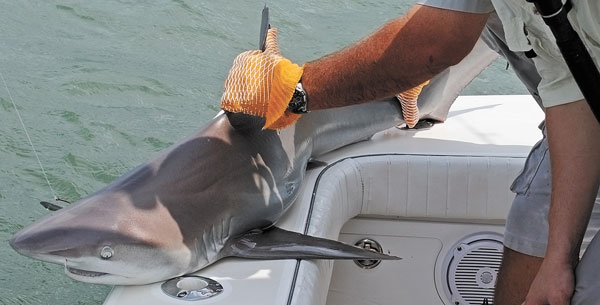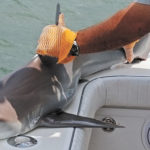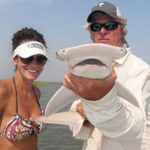
Fishing for sharks is a favorite pastime of Capt. Fritz Von Kolnitz, a Lowcountry native who doesn’t overlook the inshore action provided by the smaller bonnetheads. Inshore action for trout and bass can slow down to an early morning-only bite, but sharks continue to munch in the summer sun of August.
Von Kolnitz said the inshore shark action is a perfect fit for family fishing trips.
“I’ve been taking some of the same (families) for the past several years, and I have seen the same kids change from not wanting to fish to telling me what to do when they come aboard,” said Von Kolnitz, who runs Adventure Outdoors Charters (843-345-9969). “When you ask them what kind of fish they want to catch, sharks are always the No. 1 answer.
“I’ve had kids catch a 20-pound trophy redfish and a 3-foot sharpnose shark before, and all they want to talk about is catching that shark,” Von Kolnitz said.
But hey, catching a shark can bring the kid out in anyone, whether it’s a small sandbar or a smooth dogfish shark. The most-consistently targeted shark, however, is the bonnethead, known for its distinctive shovel-shaped nose.
Von Kolnitz, who operates out of Isle of Palms Marina, can carry six passengers comfortably, and on a lot of his trips, he heads only a short distance up the ICW to the “shark hole” at Dewees Inlet. The 85-foot inshore hole that is within eyeshot of the Atlantic Ocean is well known to many anglers, and in saltwater, you never know what else might bite your line there.
“I use a 5/0 red circle hook for everything these days because it is a good all-around inshore hook for everything from sharks to big redfish,” Von Kolnitz said. “I prefer to fish with a half of a blue crab for bait, but I’ll also use mullet and menhaden (live or dead). We might catch 10 or more sharks on a half-day trip, but what I like is that you can count on sharks to bite even in hot weather.”
The average bonnethead weighs around 10 pounds, but the Charleston area has a world-class bonnethead fishery and is home to some IGFA records. Sharks aren’t too particular, so even if the only bait source you have is frozen shrimp, go ahead and give that a try. Von Kolnitz said that leftover claws from blue crabs can be utilized at the end of the day to serve as a brief chum session for one last feeding frenzy.
Angler Amber Carter used an Ugly Stik rod paired with a Penn 320 GTI reel to catch sharks with Von Kolnitz one day recently.
“I’ve caught bigger sharks, but these bonnetheads are strong and seem to be all muscle,” said Carter.
Von Kolnitz deems sharks as “handlers” if they are less than five feet long; he likes to try and get the hook out before releasing one. Anything over that length and he prefers the non-handling option, which is to simply cut the line.
How about the myth that you can’t hurt a shark by handling him?
“As with any other fish, make your photos as soon as you handle him, and get that shark right back in the water,” Von Kolnitz said. “Don’t put your hands over their gills too hard, because that’s how they breathe.”
Von Kolnitz knows that conservation practices, even for sharks, need to be taught to all anglers, but especially to the young anglers that he guides. He has a special, 2-hour afternoon shark charter available so that vacationing families with kids can find out whether fishing is the way they want to spend their time.
Another shark-trip option is what Von Kolnitz calls “bird-dogging” for sharks behind shrimp boats near the Charleston jetties and the Morris Island lighthouse.
“Follow the fleet and watch where the dolphins are, because they will be right behind the shrimp nets. Be mindful of your tackle, because it’s never an option to get tangled in their gear,” Von Kolnitz said. “They are constantly clearing their decks of by-catch, which provides a consistent bait source that the blacktip sharks are not going to pass up.”
Whole mullet is the best bait choice when bird-dogging, but anything that is bloody might produce a strike from a shark.
Fishing behind the shrimp boats requires stout tackle, as blacktips will average around 25 pounds, with a 50-pounder not uncommon. Von Kolnitz uses conventional reels with 30-pound main line and a mono leader.
“The leader can be anywhere from 100- to 150-pound test, and I prefer it to a wire leader that can cut and damage a shark,” he said.
“I’ve had a few 100-pound blacktips jumping and spinning behind the boat before, and sometimes during August, a tarpon gets in the mix, too.”





Be the first to comment